Owners of private real estate always have a lot of things that have no place in a residential building. For their storage, separate buildings are being erected, differing in location, architecture and size. The optimal solution to such situations in all respects is a frame shed with a pitched roof. It is possible to build such a structure quickly and inexpensively, the procedure is simple, but requires minimal knowledge and skills.
Design features of a shed with a pitched roof
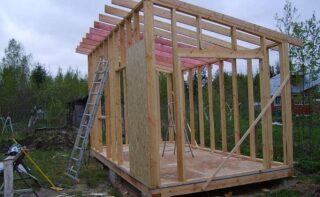
To build even the simplest barn from a 100x100 bar with your own hands, you need to figure out the device, the procedure and the rules for the construction of the structure. The finished building is notable for its practicality, functionality and minimal maintenance costs.
The buildings consist of the following parts:
- Foundation. A monolithic slab is made, flooring on piles and a grillage, sometimes the supports are simply concreted.
- Floor. Depending on the type of soil, a decision is made in favor of boards, paving slabs or an embankment of crushed stone with sand.
- Walls. The best option is a frame with mineral wool insulation and chipboard sheathing.
- Roof. Constructed from a rafter system and roofing. The difference in the height of the walls forms a slope, the magnitude of which is determined by climatic conditions and the type of cladding.
The utility unit is equipped with a window, ventilation, and sometimes drainage. A competent approach to business and correct calculation allows you to get an excellent result.
The advantage of a shed roof for outbuildings
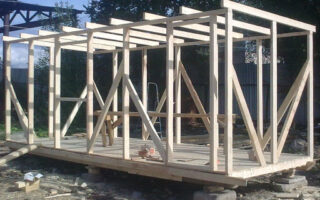
A lightweight roofing structure, which consists of only one inclined slope, is chosen in cases where there are no special requirements for the structure in terms of comfort, coziness and interior decoration. Outbuildings perform their functions in relation to the protection of internal contents from unauthorized persons and natural factors.
The shed roof has the following advantages:
- Ease of planning, no complicated calculations. Designing can be done even by beginners.
- Affordable cost. This applies both to the materials and to the construction process itself. There is no need to involve heavy equipment and hired workers.
- Practicality. The barn, for all its simplicity, perfectly protects property from wind, moisture and temperature changes.
There is no attic space, thermal insulation, as a rule, is not done.
Types of shed roof structures
The shed roof of the shed looks like half a gable structure. Truss systems similar to these projects can be used.
- Sliding. Steel locks are used, thanks to which the rafters are shrinking during the shrinkage of the log house. The top of the system is rigidly fixed to the beam, and the lower one slides along the supports as the walls shrink.
- Forced. Stationary and fixed devices. The rafter legs rest not only on the outer walls, but also on the inner racks. Part of the load is transferred to the internal partitions
Sometimes truss systems are not used, the roof is laid immediately on the walls with different heights along the facade and back.
Barn frame
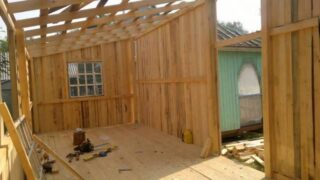
The choice of material for creating the frame is determined based on the climatic conditions and characteristics of the property that is planned to be stored in the building. In conditions where there are no strong winds and a large snow load, a light frame made of boards for a barn is quite suitable. When these indicators are close to critical values, you need to build a shed from a bar of 50x50 mm.
In all cases, the following wall construction scheme is recommended:
- External cladding. Sheathing with siding under a bar or corrugated board is carried out.
- Waterproofing. You can take a special film, but it is cheaper to use roofing material.
- The skeleton. It is made in the form of a lattice with a mesh of 50-100 cm, depending on the strength of the racks.
- Insulation. The choice is large - polyurethane foam, foam plastic, mineral wool, eco-cellulose, expanded clay.
- Vapor barrier. The canvas is stuffed onto the frame and provides moisture removal from the room.
- Internal lining. Given the specifics of the structure, it is better to focus on OSB or waterproof plywood.
Windows and doors are made of timber or are bought ready-made.
What materials are they built from?
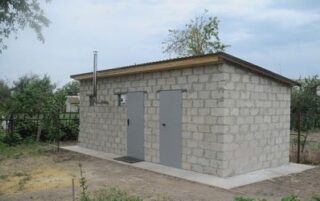
To make a sturdy and comfortable household unit, materials are used that are optimally suited for the intended purposes.
The choice is as follows:
- Wood. Logs, beams, boards are used. Raw materials must be treated with antiseptics and fire retardants.
- Metal. Channel and corner are strong and durable. Fastening is carried out by welding or corners.
- Blocks. Ancillary structures are made of foam concrete, cinder block or clay bricks. Capital structures imply the arrangement of a powerful and expensive deep foundation.
If you have several types of material in stock, you can combine them. The plinth is made of bricks, the frame is made of steel profiles, and the truss system is made of wood.
Choosing a place for construction
The main options are joint or separate placement of the building. In the first case, the slope of the roof is made towards the facade, and in the second - in the opposite direction.
If a decision is made in favor of a separate building, you should adhere to the following rules:
- Use of the least suitable territory for any economic activity. Almost every site has an abandoned corner, a shaded place, poor black soil.
- A point that does not interfere with the passage of people, the supply of communications, the passage of vehicles.
- Lack of underground pipelines nearby.
Before finally deciding on the construction site, you should ask a specialist for advice.
Work order
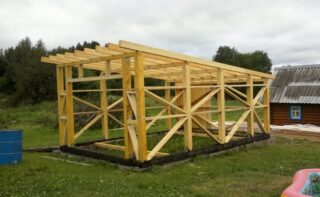
At the preparatory stage, the equipment of the structure is determined, a drawing is made, and an estimate is drawn up. Then you need to purchase materials and assemble a complete set of tools. It is necessary to start construction in the warm season, with a long-term forecast of dry weather.
Step-by-step instructions for erecting a shed with a pitched roof:
- Marking on the ground. Determination of the construction site, orientation to the cardinal points, clearing the site from vegetation and debris. Preparing waste bags.
- Making the base. Piles are screwed in, columns are made, columns are dug in, or a monolithic slab is poured. If a basement is provided, a recessed tape is made.
- Assembling the frame. First, the lower harness is mounted, then the supports, and then the upper harness. Cross members are installed between the racks. Openings for doors and windows are outlined.
- Floor arrangement. Depending on the characteristics of the base, boards, paving slabs, bricks or reinforced concrete slabs are laid.
- Assembling the rafter system and lathing. First, the rafter system is assembled. The Mauerlat is attached, then the rafter legs, then the waterproofing, counter-lathing and lathing are nailed. A roof covering is laid on top of the slats. When the building is covered, insulation is laid, overhangs and gables are made.
In conclusion, finishing work is carried out.
Builders recommend opting for combined sheds. It is convenient in terms of everyday life and cheaper, as money is saved on the construction of one wall. The slope of the roof must be sufficient to effectively evacuate snow and water. It is necessary to waterproof each element of the building.








